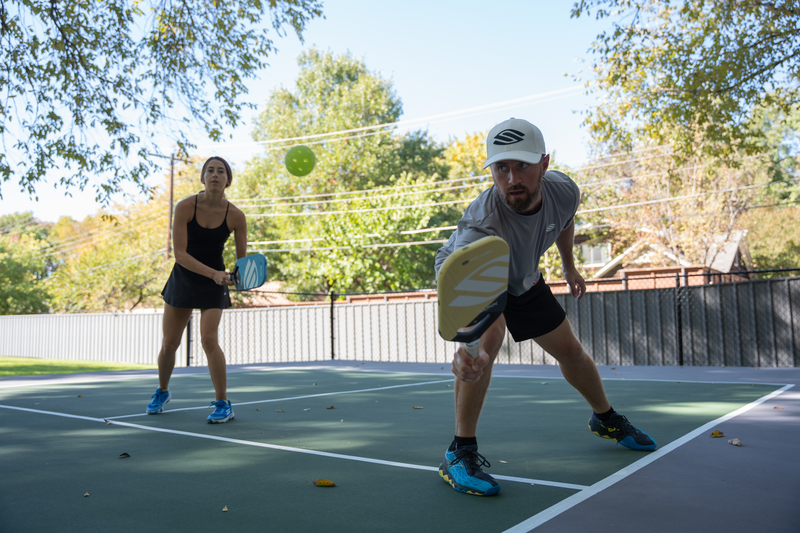A pickleball fault is any rule violation that will stop play. But there are so many. Although there are slightly different rules for faults in officiated and non-officiated games, this list is meant for recreational pickleball players — so all the faults listed here are specifically from non-officiated rules. Here is a comprehensive list of the many faults in pickleball.
Basic rules of pickleball faults
Faults in pickleball are important because they can lead to a point, either for you or your opponent.
- If the receiving team commits a fault, it will result in a point for the serving team.
- If a serving team commits a fault, it will result in loss of serve or “side out.”
Pickleball faults
These are the faults you can commit in pickleball:
Serving faults
- A serve does not land within the cross-court area from where the serve originated.
- The serve can land on the sidelines and baseline, but must not contact the non-volley (or “kitchen”) line.
- A player on the receiving team does not allow for one bounce after the serve.
- A player on the serving team does not allow for one bounce after the serve return.
- During a serve, the server does not have at least one foot on the playing surface behind the baseline.
- One or both of a server’s feet are touching the court on or inside the baseline.
- One or both of a server’s feet is touching the playing surface outside the imaginary line of the sideline or centerline.
- The serving team players are not in their correct positions during the serve:
- When a team has an even score (0, 2, 4, etc.) the player who first served first should be on the right side of the court and on the left side of the court when the score is odd, whether or not they are serving.
- When a team has an odd score (1, 3, 5, etc.) the player who first served first should be on the left side of the court and on the right side of the court when the score is odd, whether or not they are serving.
In-play faults
- The ball is hit into the net on the serve or any return, and does not cross over into the opponent’s side.
- The ball is allowed to hit the net if it ends up landing on the court of the player’s opponent (except during the serve).
- A ball hit by a player that first landed out of bounds or on their own side of the court.
- The ball is hit out of bounds.
- A ball bounces twice before being returned.
- During play, a ball is stopped by a player (for instance, catching the ball, being hit by the ball, or otherwise stopping it in flight) before the ball becomes dead.
- If the play is stopped by a referee, the rally shall be replayed.
- A player who catches or carries the ball on their paddle (during a serve or a rally).
- The player’s intention does not matter, in relation to this rule.
- A hinder (anything that might distract or otherwise restrict a player) is called by a player, but then ruled invalid by the referee.
- A ball is hit twice by the same team, either by the same player or both player on a team, unless it is done in a “continuous, single-direction stroke by one player.”
- The player’s intention does not matter, in relation to this rule.
- A player distracts any opponent that is about to play the ball.
Net faults
- The ball is hit below the net or between the net and net post.
- A player hits a ball before it entirely crosses the plane of the net.
- A player goes around the net post and crosses the imaginary extension line of the net but does not hit the ball.
- A player is allowed to go around the net and cross the imaginary extension line of the net after hitting a ball.
Non-volley (“kitchen”) zone faults
- A player volleys the ball (hits the ball out of the air before it bounces) from the non-volley zone (NVZ).
- This includes any object that has contact with the player, such as clothing, a paddle, or their partner.
- If a player volleys a ball and then their momentum brings them into the NVZ.
- The fault occurs even if the ball becomes dead before the player steps into the NVZ.
- If a player volleys a ball and their momentum causes them to touch anything in the non-volley zone, including their partner, paddle, or clothing.
- The fault occurs even if the ball becomes dead before the player steps into the NVZ.
- A player volleys the ball after being in the NVZ, without establishing both feet back onto the playing surface outside the kitchen zone.
Gear faults
- A player, their clothing, or their paddle touches the net, net posts, or opponent’s court when the ball is in play.
- A ball hits a player, their clothing, or anything else they are wearing or carrying — except the paddle or the part of the player’s hands that are in contact with the paddle and below the wrist.
- The fault is given to the player who was hit by the ball.
- While in play, a ball hits any permanent object before bouncing on the court.
- A player is allowed to carry extra balls during play as long as they are not visible to their opponent. It becomes a fault when the extra ball or falls on the playing surface during play.
- A player uses or carries more than one paddle during a rally.
- A player does not have possession of their paddle when it makes contact with the ball.
- A player uses any form of headphones or earbuds.
- Prescribed or necessary hearing aids are allowed.
Player position faults
- A server does not serve from the proper position.
- In singles, the server must serve from the right side of the court if their score is even (2, 4, 6, etc.), and from the left side of the court if their score is odd (1, 3, 5, etc.).
- In doubles, each serve after a side-out or fault will occur from the right serving area.
- After each won point, the server shall alternate sides of the court baseline.
- In singles, the server will alternate serving area sides.
- In doubles, the server will switch serving area sides with their partner after each point.
- If server 1 on a team faults, the two players on the team will not switch serving area sides before player 2’s serve.
Faults for stopping a rally
- A player stops a rally for a suspected broken, cracked, degraded, or soft ball. The player must wait until the end of the rally to inspect the ball.
- After the rally is over, if both teams (in rec play) agree that the ball impacted the rally, then a replay will take place.
- If a player stops a rally due to an injured player.
- The rally should play out until it naturally ends.
- It is a fault of the player who stopped the rally.
- If a player stops a rally because of a player equipment issue, like a player losing an item (including their paddle) or breaking a paddle.
- It is a fault of the player who stopped the rally.
- If a player stops a rally because of an item on the court (unless the ball lands in the NVZ as a direct result of a volley), even if the ball hits the item.
- It is a fault of the player who stopped the rally.
- If a player stops a rally and incorrectly identifies a player or position error.
- It is a fault of the player who stopped the rally.
Learning all the faults in pickleball
There are a lot of pickleball faults to learn, but really only a few that cause the majority of dead balls (“out” balls, line faults, etc.).
If you are learning pickleball for the first time, learning the basics should be your number one priority. As you play more and more, these faults will become second nature, and you will be able to focus on improving your game.

